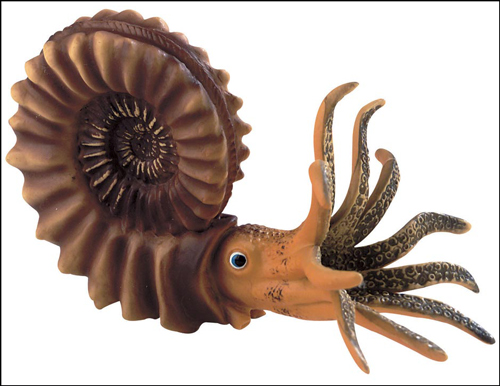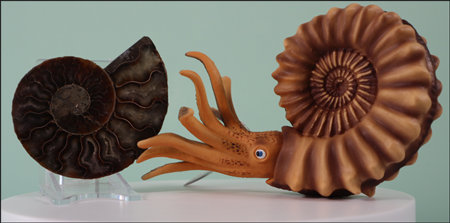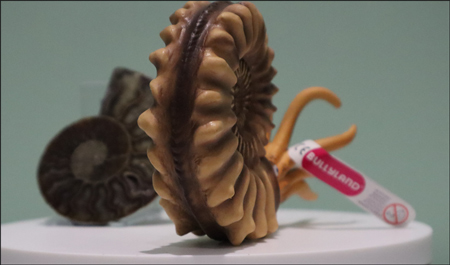Popular Bullyland Ammonite Model “Turntable Tuesday”
“Turntable Tuesday” Bullyland Ammonite Model
It’s “Turntable” Tuesday at Everything Dinosaur! The time of the week when we put another prehistoric animal model on our turntable and give it a spin. Today, it is the turn of the Bullyland ammonite model, the first invertebrate to feature in this series and an ammonite replica that it is used by museums all over the world to illustrate the Ammonoidea.
The Bullyland Ammonite Model “Turntable Tuesday”
Video credit: Everything Dinosaur
Ammonite Replicas
The Bullyland ammonite is one of the most popular figures in the German company’s “Dinosaur Park” range. It depicts a typical ammonite, with large eyes, a hypernome and a beautifully detailed beak (mouth). The shell has an inverted keel and it is strongly ribbed, characteristics associated with a number of known genera from both the Jurassic and Cretaceous geological periods.
The Bullyland Ammonite Model

Visit the award-winning and user-friendly Everything Dinosaur website: Everything Dinosaur.
Ubiquitous and Important Extinct Group of Cephalopods
Although extinct, animals in the Subclass Ammonoidea are extremely important to scientists. Ammonites are members of the Mollusca Phylum that lived in chambered shells and were entirely marine. Many hundreds of different genera are known. The ability to evolve rapidly, to leave abundant fossil material in the form of their fossilised shells (comprised of aragonite, a naturally occurring crystalline form of calcium carbonate), has made these molluscs ideal candidates for zonal fossils.
Outcrops of rock, although in some cases, separated by thousands of miles and composed of different constituents, limestone and sandstone for example, can be correlated due to the fact that they contain similar ammonite fossils. The technique of using fossils to identify the relative age of sediments is called biostratigraphy. Rock layers are divided into distinct and easily identifiable zones as they are characterised by one or more particular fossil species. Ammonites make ideal zone fossils.
The Bullyland Ammonite Model is Often Used in Museum Exhibits

Picture Credit: Everything Dinosaur
Used in Museum Displays and Exhibits
In the short video, the ammonite model is shown next to a fossil specimen. Many museums use the Bullyland ammonite replica in display cases so that visitors can get an idea of what the living animal was like whilst they view the fossilised remains of the ammonite aragonite shells.
The Posterior Portion of the Bullyland Ammonite Model

Picture credit: Everything Dinosaur
The Bullyland Ammonite Model Features in “Turntable Tuesday”
The “turntable Tuesday” ammonite model video, lasts a little over two minutes, it is one of a series of videos posted on Everything Dinosaur’s YouTube channel showcasing different replicas. To view these videos check out our YouTube channel: Everything Dinosaur on YouTube.
We recommend that readers subscribe to Everything Dinosaur on YouTube.
To view the Bullyland ammonite model and to see the rest of the Bullyland prehistoric animal models available from Everything Dinosaur: Bullyland Dinosaurs and Prehistoric Animal Models.

